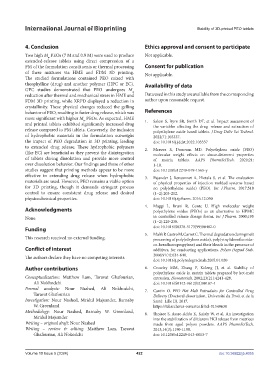Page 430 - IJB-10-5
P. 430
International Journal of Bioprinting Stability of 3D-printed PEO tablets
4. Conclusion Ethics approval and consent to participate
Two high M PEOs (7 M and 0.9 M) were used to produce Not applicable.
w
extended-release tablets using direct compression of a
PM of the formulation constituents or thermal processing Consent for publication
of these mixtures via HME and FDM 3D printing. Not applicable.
The studied formulations contained PEO mixed with
theophylline (drug) and another polymer (HPC or EC). Availability of data
GPC studies demonstrated that PEO undergoes M
w
reduction after thermal and mechanical stress in HME and Data used in this study are available from the corresponding
FDM 3D printing, while XRPD displayed a reduction in author upon reasonable request.
crystallinity. These physical changes reduced the gelling
behavior of PEO, resulting in faster drug release, which was References
more significant with higher M PEOs. As expected, HME 1. Salem S, Byrn SR, Smith DT, et al. Impact assessment of
w
and printed tablets exhibited significantly increased drug the variables affecting the drug release and extraction of
release compared to PM tablets. Conversely, the inclusion polyethylene oxide based tablets. J Drug Deliv Sci Technol.
of hydrophobic materials in the formulation outweighs 2022;71:103337.
the impact of PEO degradation in 3D printing, leading doi: 10.1016/j.jddst.2022.103337
to extended drug release. These hydrophobic polymers 2. Meruva S, Donovan MD. Polyethylene oxide (PEO)
(like EC) are beneficial as they prevent the disintegration molecular weight effects on abuse-deterrent properties
of tablets during dissolution and provide more control of matrix tablets. AAPS PharmSciTech. 2020;21:
over dissolution behavior. Our findings and those of other 1-10.
studies suggest that printing methods appear to be more doi: 10.1208/s12249-019-1565-y
effective in extending drug release when hydrophobic 3. Pajander J, Rensonnet A, Hietala S, et al. The evaluation
materials are used. However, PEO remains a viable option of physical properties of injection molded systems based
for 3D printing, though it demands stringent process on poly(ethylene oxide) (PEO). Int J Pharm. 2017;518
control to ensure consistent drug release and desired (1–2):203-212.
physicochemical properties. doi: 10.1016/j.ijpharm. 2016.12.050
4. Maggi L, Bruni R, Conte U. High molecular weight
Acknowledgments polyethylene oxides (PEOs) as an alternative to HPMC
None. in controlled release dosage forms. Int J Pharm. 2000;195
(1–2):229-238.
Funding doi: 10.1016/S0378-5173(99)00402-0
5. Malik P, Castro M, Carrot C. Thermal degradation during melt
This research received no external funding. processing of poly(ethylene oxide), poly(vinylidenefluoride-
co-hexafluoropropylene) and their blends in the presence of
Conflict of interest additives, for conducting applications. Polym Degrad Stab.
2006;91(4):634-640.
The authors declare they have no competing interests.
doi: 10.1016/j.polymdegradstab.2005.01.020
Author contributions 6. Crowley MM, Zhang F, Koleng JJ, et al. Stability of
polyethylene oxide in matrix tablets prepared by hot-melt
Conceptualization: Matthew Lam, Taravat Ghafourian, extrusion. Biomaterials. 2002;23(21):4241-428.
Ali Nokhodchi doi: 10.1016/S0142-9612(02)00187-4
Formal analysis: Nour Nashed, Ali Nokhodchi, 7. Cantin O. PEO Hot Melt Extrudates for Controlled Drug
Taravat Ghafourian Delivery (Doctoral dissertation, Université du Droit et de la
Investigation: Nour Nashed, Mridul Majumder, Barnaby Santé–Lille II). 2017.
W. Greenland https://tel.archives-ouvertes.fr/tel-01540630
Methodology: Nour Nashed, Barnaby W. Greenland, 8. Shojaee S, Asare-Addo K, Kaialy W, et al. An investigation
Mridul Majumder into the stabilization of diltiazem HCl release from matrices
Writing – original draft: Nour Nashed made from aged polyox powders. AAPS PharmSciTech.
Writing – review & editing: Matthew Lam, Taravat 2013;14(3):1190-1198.
Ghafourian, Ali Nokodchi doi: 10.1208/s12249-013-0013-7
Volume 10 Issue 5 (2024) 422 doi: 10.36922/ijb.4055

